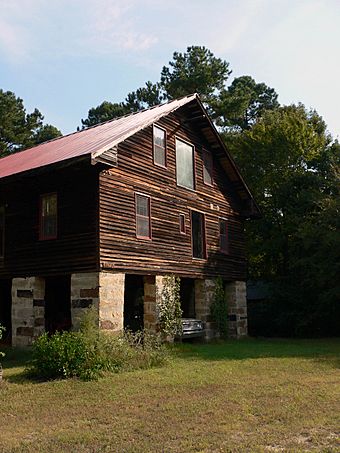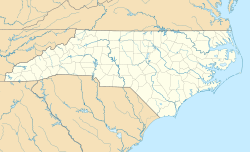Walnut Hill Cotton Gin facts for kids
Quick facts for kids |
|
|
Walnut Hill Cotton Gin
|
|
 |
|
| Location | 4620 Mial Plantation Road, Knightdale, North Carolina |
|---|---|
| Nearest city | Shotwell, North Carolina |
| Area | 0.5 acres (0.20 ha) |
| Built | c. 1848 |
| MPS | Wake County MPS |
| NRHP reference No. | 86001631 |
| Added to NRHP | August 14, 1986 |
Imagine a machine that helped farmers turn fluffy cotton into useful fabric! The Walnut Hill Plantation cotton gin house is a very old building in North Carolina. It was built around the 1840s by a man named Alonzo T. Mial. He was an important farmer and businessman back then. This gin house is special because it's one of the few left in the state. It also still has most of its original cotton ginning machines inside!
Contents
What is a Cotton Gin House?
A cotton gin house was a building where a special machine, called a cotton gin, was used. This machine quickly separated cotton fibers from their seeds. Before the cotton gin was invented, this work had to be done by hand. It was a very slow and difficult job. The cotton gin made it much faster to prepare cotton for making clothes and other items.
The Walnut Hill gin house is about two and a half stories tall. It is made from strong, hand-cut wooden beams. The building is about 36 feet wide and 56 feet deep.
How the Gin House Was Built
The front part of the building stands on tall, thick granite pillars. These pillars create an open space on the ground floor. This is where the mules walked in a circle to power the gin. The back part of the gin house rests on shorter granite supports. This area held the rooms where cotton was pressed and packaged. Most of the ginning machines were on the second floor. The third floor was used to store cotton that had already been processed.
How the Cotton Gin Worked
At first, the gin was powered by two to four mules. These mules were hitched to long wooden poles called "sweeps." As the mules walked in a circle, they turned a tall, vertical power shaft. This shaft was connected to a series of gears. The gears then turned a leather belt that made the gin machine work.
In 1875, Alonzo Mial made a big upgrade. He replaced the mules with a powerful 15-horsepower steam engine. This new engine made the gin work much faster. It allowed the gin to process a lot more cotton. Over the next 50 years, the gin house received other improvements as technology got better. The Walnut Hill cotton gin stopped working in the mid-1930s. This was shortly after Alonzo Mial's oldest son, Millard Mial, passed away.
A New Life for the Gin House
In 1992, an architect named Jim Smith and his wife bought the old gin house. They spent the next ten years working to make sure the building wouldn't fall apart. They wanted to stop it from getting worse.
Between 2003 and 2005, they completely renovated the gin house. They turned it into a private home where they have lived ever since. Their amazing work on the gin house won them an award in 2011. It was called the AIA North Carolina Design Merit award.



